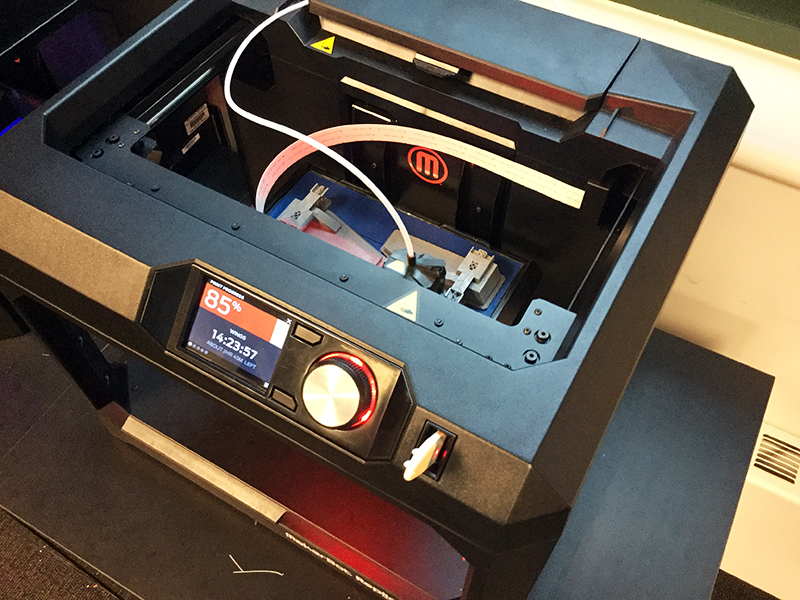
3-D printer in progress of printing student’s class assignment at the Digital Union in Stillman Hall. Credit: Abby Vesoulis | For The Lantern
When Maddie, a 1-year-old German shepherd, came to the Ohio State University Veterinary Medical Center, her future looked bleak. The dog had a serious pelvic fracture through her left hip joint, likely the result of being hit by a car.
Luckily for Maddie, Dr. Jonathan Dyce, associate professor of small animal orthopedics, had a plan. Dyce 3-D printed Maddie’s deformed limb to help visualize and plan her reconstructive operation.
Dogs like Maddie have benefited from the use of 3-D printing in medicine, and humans can, too. Across all medical fields at OSU, experts have been cultivating uses and advancements in three-dimensional printing. Dr. David Dean, associate professor of plastic surgery at the Wexner Medical Center, uses 3-D printing to help patients, and he said he is working on a project aimed to help wounded veterans who suffer facial traumas.
Injured soldiers are surviving injuries they had not in the past due to very sophisticated body armor and improvements in medicine. However, the veterans’ faces, hands and feet are still exposed to the elements of war, Dean said.
“So when an improvised explosive device detonates or if they are hit by a rocket-propelled grenade or something like that, those exposed areas can be affected,” Dean said.
Dean is currently working on an approach of bone regeneration in which they will 3-D print re-absorbable jaw implants for traumas such as those sustained by these veterans. Funded by the U.S. Department of Defense’s Armed Forces Institute of Regenerative Medicine, the goal is for the project’s research to be applicable in a clinical setting by 2018, he said.
Current procedures require taking an existing material off a shelf and trimming it down to fit the patient.
“Unless you fully customize these types of implants, you run the risk of damaging surrounding tissue,” Dean said. Using a 3-D printer allows for a patient-specific implant.
Dyce was also able to use the additive manufacturing technology to help Quasimodo, an American Staffordshire bull terrier mix. The dog faced dislocation of its wrists on both sides due to a developmental deformity, which made them bend at 90-degree angles.
Printing both of the dog’s legs helped determine the amount of reconstruction that would be necessary and to plan the reconstructive surgery. Dyce said that he initially thought that multiple levels of correction would be required, but the models indicated that a multiplanar but single level reconstruction around the wrists would allow Quasimodo to stand square.
“More surgery generally means greater potential for complication and the utility of the models is to reduce surgical morbidity and hasten recovery,” Dyce said in an email.
Dyce’s patients Maddie and Quasimodo both had successful surgeries, and increasingly, board-certified veterinarians are referring cases to OSU’s Veterinary Medical Center to guarantee the best outcome for their canine patients, Dyce said.
“Reconstructive orthopedics is an emerging discipline in veterinary surgery,” Dyce said. “3-D printing is allowing us to push the envelope of restoration of function safely with precision, and tailored to the individual patient.”


